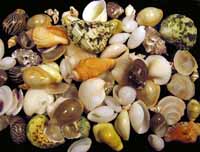In the rare case that some of you ask us, our shells (true,not reproductions) are precisely ... just shells, ie without the mollusk that produced them. They come from different seas and oceans, particularly in the Pacific, with the exception of course of the Pulmonate that are on the mainland.
So in the catalog you'll find whether Gastropoda (cypraee, murices, cones…), ie the kind of shellfish whose shell is composed of a single part with an opening from which the animal escapes, or Bivalvia (pectines, cockles, clams...) so called because their shell is divided in two parts know as the "valves"; but we have also Scaphopoda, tusk of elephant shaped, and the Cephalopoda with external shell (excluded therefore small cuttlefishes, octopuses and calamaries!), like the famous Nautilus (not the submarine…).
Like for every category, our catalogs are subject to frequent revision, so you often come back to visit us if you are searching for novelties.
And now… good fishing!
-
Minerals & Gems
- Dropdown gift ideas
-
Dropdown crystaltherapy
- Dropdown lots kits and packaging
- Dropdown tumbled stones
- Dropdown worked points
- Dropdown masseurs sticks pebbles salts
- Dropdown pendulums or pendants
- Dropdown pyramids
- Dropdown spheres and eggs (ovos)
- Dropdown agata slices
- Dropdown figured stones
- Dropdown moqui abalone Apache tears shiva lingam
- Dropdown ornaments and gadgets
- Dropdown costume jewelry tumbled stones
- Dropdown jewels and worked gems
- Dropdown raw minerals, rocks and crystals
- Dropdown meteorites volcanoes
-
Insects
- Dropdown gift ideas
- Dropdown butterflies (Lepidoptera)
- Dropdown coleopters
- Dropdown arachnids
- Dropdown dragonflies
- Dropdown hymenopters
- Dropdown hemipterons
- Dropdown Diptera
- Dropdown orthopterians
- Dropdown other insects
- Dropdown italian palearctic insects
- Dropdown insects stocks
- Shells
- Sharks
- Other Items
-
Fossils
- Dropdown gift ideas books
- Dropdown reptiles and dinosaurs
- Dropdown mammals
- Dropdown fishes and sharks
- Dropdown amphibians and birds
- Dropdown ammonites and shells
- Dropdown trilobites and other invertebrates
- Dropdown ambers and vegetables
- Dropdown stone hand-made other
- Dropdown fossil stocks and in boxes
- Taxidermy
- Equipment



 FIRST
FIRST 

